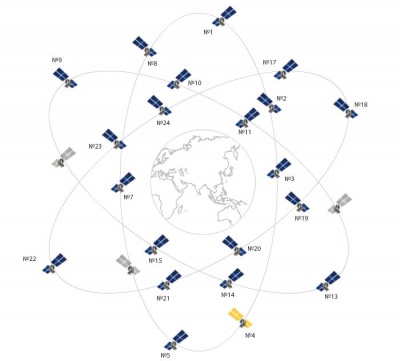If you wish to contribute or participate in the discussions about articles you are invited to contact the Editor
GLONASS Space Segment: Difference between revisions
mNo edit summary |
|||
| Line 75: | Line 75: | ||
|align="center"|PZ-90.02 | |align="center"|PZ-90.02 | ||
|align="center"|WGS-84 | |align="center"|WGS-84 | ||
|align="center"|GTRF} | |align="center"|GTRF | ||
-|} | |||
==GLONASS Satellite Description== | ==GLONASS Satellite Description== | ||
Revision as of 07:18, 12 July 2011
| GLONASS | |
|---|---|
| Title | GLONASS Space Segment |
| Author(s) | GMV |
| Level | Basic |
| Year of Publication | 2011 |
The main functions of the Space Segment are to transmit radio-navigation signals, and to store and retransmit the navigation message sent by the Control Segment. These transmissions are controlled by highly stable atomic clocks on board the satellites.[1]
Two main aspects define the space segment: One is the number of satellites in the constellation to ensure that the users will have, at least, 4 simultaneous satellites in view from any point at the earth surface at any time. The other aspect is the features of the satellites that occupy each orbital slot.
GLONASS Satellite Constellation
The GLONASS space segment consists nominally of 24 operational satellites, distributed over three orbital planes.[2] At the time of editing this article (June 2011), the number of satellites in the constellation is 27, 23 operational, one in commissioning phase and three in maintenance.[3]
The longitude of ascending node differs by 120 deg from plane to plane. Each plane comprises eight satellites, staggered by 45 deg in argument of latitude. The arguments of latitude of satellites in equivalent slots in two different orbital planes differ by 15 deg. Each satellite is identified by its slot number, which defines the orbital plane and its location within the plane.[4]
The GPS space segment also consists of nominally 24 satellites, which are, however, distributed over six orbital planes, differing from plane to plane by 60 deg in longitude of the ascending node.
GLONASS satellites operate in circular orbits at an altitude of 19100-km, an inclination of 64.8 deg and each satellite completes the orbit in approximately 11 hours 15 minutes. This means that for a stationary observer the same satellite is visible at the same point in the sky every eight sidereal days. Since there are eight satellites in each orbital plane, each day a different satellite appears at the same point in the sky. With the 11 h 58 min orbital period for GPS satellites, the same GPS satellite is visible at the same point in the sky every (sidereal) day.
Besides its atomic clocks and the equipment for receiving, processing, storing and transmitting navigational data, GLONASS satellites carry an extensive propulsion system, enabling the satellite to keep its orbital position, to control its attitude and even to manoeuvre to a different orbital position. The attitude control system obtains its information from a number of different sensors, including an earth sensor and a magnetometer. Reflectors on the satellite body near the transmission antennae serve for purposes of laser ranging from ground stations.[5]
Differences between GPS and GLONASS constellations are summarized in the following table:[6]
| GLONASS | GPS | GALILEO | |||||||||||||||||||||||||||||||||
|---|---|---|---|---|---|---|---|---|---|---|---|---|---|---|---|---|---|---|---|---|---|---|---|---|---|---|---|---|---|---|---|---|---|---|---|
| Number of satellites | 24 | 30 | 30 | ||||||||||||||||||||||||||||||||
| Number of orbital planes | 3 | 6 | 3 | ||||||||||||||||||||||||||||||||
| Orbital Inclination | 64°8' | 55° | 56° | ||||||||||||||||||||||||||||||||
| Orbital altitude | 19.140 km | 20.180 km | 23.222 km | ||||||||||||||||||||||||||||||||
| Period of revolution | 11h 15m | 11h 58m | 14h 22m | ||||||||||||||||||||||||||||||||
| Launch site | Baikonur/Plesetsk | Cape Canaveral | Kourou (French Guiana) | ||||||||||||||||||||||||||||||||
| Date of first launch | 02/10/82 | 22/02/78 | N/A | ||||||||||||||||||||||||||||||||
| Satellites for launch | 1/3 | 1 | 2 | ||||||||||||||||||||||||||||||||
| Datum | PZ-90.02 | WGS-84 | GTRF
-|} GLONASS Satellite DescriptionGLONASS satellites are divided into blocks. Each block is a set of satellites usually launched within certain time interval. Below there is a brief description of the different blocks:[1]
A modernized GLONASS-K satellite, GLONASS-KM, for launch after 2015 [9] may also transmit on the GPS L5 frequency at 1179.45 MHz. An alternative to the present three-plane, equally spaced satellite constellation, is also under consideration. Finally, the following table gathers the main characteristics of the different GLONASS satellite blocks:[6]
NotesReferences
|


